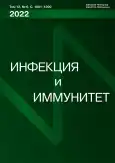Искусственный интеллект в иммунодиагностике хронического пародонтита
- Авторы: Мудров В.П.1,2
-
Учреждения:
- ФГБОУ ДПО Российская медицинская академия непрерывного профессионального образования Минздрава России
- ГБУ Диагностический клинический центр № 1 Департамента здравоохранения г. Москвы
- Выпуск: Том 12, № 6 (2022)
- Страницы: 1186-1190
- Раздел: КРАТКИЕ СООБЩЕНИЯ
- URL: https://journal-vniispk.ru/2220-7619/article/view/119199
- DOI: https://doi.org/10.15789/2220-7619-AII-1999
- ID: 119199
Цитировать
Полный текст
Аннотация
Искусственный интеллект используется для диагностики различных заболеваний полости рта. В области клинической лабораторной диагностики алгоритмы машинного обучения применяются в интерпретации сложных биохимических данных. Точную диагностическую информацию о пародонтите можно получить при создании комбинации соответствующих биомаркеров с необходимой чувствительностью и специфичностью. Целью настоящего исследования стал поиск значимых инфекционно-иммунологических клинико-лабораторных данных на основе алгоритма машинного обучения при хроническом пародонтите. Для этого обследовано 124 пациента в возрасте от 40 до 70 лет с диагнозом «Хронический пародонтит», которым методом ПЦР в реальном времени провели исследование кармана пародонта на ДНК вирусов герпеса человека и бактериальную пародонтопатогенную микрофлору Аggregatibacter actinomycetemcomitans, Fusobacterium nucleatum, Tannerella forsythia, Treponema denticola, Prevotella intermedia, Porphyromonas endodontalis, Porphyromonas gingivalis. Также изучались матричные РНК провоспалительных цитокинов и другие маркеры хронизации воспалительного процесса: IL-1β, IL-10, IL-18, TNFα, TLR4, GATA3, CD68. В пробе зубодесневой жидкости определяли TNFα, IFNγ, IL-1β, IL-4, IL-6, IL-10, IL-18, VEGF. Иммунные клетки ротовой полости оценивали по содержанию CD3+, CD4+, CD8+, CD3+HLA-DR+, CD64+CD16+CD14–, Treg CD4+CD25+CD127+low, T-NK CD3+CD16+CD56+, NK CD3–CD16+CD56+, СD14+, СD14+HLA-DR+, CD19+, CD19+HLA-DR+, B1 CD19+CD5+B27–, B2 CD19+CD5–B27–, CD19+CD5–B27+. Для оценки данных использовалось машинное обучение «random forest». Была выявлена связь между патогенной микрофлорой и характером иммунного ответа. Преобладал провоспалительный компонент, выраженный в экспрессии мРНК IL-1β, TNFα, IFNγ в иммунном ответе на агрессивные пародонтопатогены: Treponema denticola, Fusobacterium nucleatum и др. Алгоритм машинного обучения «random forest» выбрал из множества данных корреляционные отношения r ≥ 0,5 (как положительные, так и отрицательные) для проведения дальнейшего анализа оператором. Модель машинного обучения «random forest» на 10% с учителем показала следующие значимые сочетания данных: VEGF, CD3+, CD14+HLA-DR, CD19+CD5–CD27+, а также мРНК TLR4, IL-1b, IL-10, TNFa, IL-18. Развитие примененной модели «random forest» машинного обучения с учителем уже на 25% показала отличия: P. endodontalis, GATA3, CD3+, CD14+, CD19+CD5–CD27+, а также мРНК TLR4, TNFa, IL-1b, IL-10, IL-18. Поиск значимых инфекционно-иммунологических клинико-лабораторных данных на основе алгоритма машинного обучения при хроническом пародонтите показал значимость в развитии остеодеструктивного воспалительного процесса мРНК провоспалительных цитокинов, моноцитов, Т-лимфоцитов и В-клеток памяти. Для поиска взаимосвязей инфекционного иммунопатологического процесса может применяться машинное обучение с учителем на базе модели «random forest», что позволяет статистически обрабатывать большие массивы данных и выявлять неявные причинно-следственные факторы.
Ключевые слова
Полный текст
Открыть статью на сайте журналаОб авторах
Валерий Павлович Мудров
ФГБОУ ДПО Российская медицинская академия непрерывного профессионального образования Минздрава России; ГБУ Диагностический клинический центр № 1 Департамента здравоохранения г. Москвы
Автор, ответственный за переписку.
Email: vpmudrov@yandex.ru
ORCID iD: 0000-0003-1129-8335
SPIN-код: 4934-3745
Scopus Author ID: 934044
ResearcherId: ABD-8217-2020
к.м.н., ассистент кафедры медицинской биохимии и иммунопатологии академического образовательного центра фундаментальной и трансляционной медицины (АОЦФТМ); врач клинической лабораторной диагностики
Россия, 125284, Москва, ул. Поликарпова, 1/10; МоскваСписок литературы
- Cabitza F., Banfi G. Machine learning in laboratory medicine: waiting for the flood? Clin. Chem. Lab. Med., 2018, vol. 56, no. 4, pp. 516–524. doi: 10.1515/cclm-2017-0287
- De Bruyne S., Speeckaert M.M., Van Biesen W., Delanghe J.R. Recent evolutions of machine learning applications in clinical laboratory medicine. Crit. Rev. Clin. Lab. Sci., 2021, vol. 58, no. 2, pp. 131–152. doi: 10.1080/10408363.2020.1828811
- Lee J.-H., Kim D.-Н., Jeong S.-N., Choi S.-H. Diagnosis and prediction of periodontally compromised teeth using a deep learning-based convolutional neural network algorithm. J. Periodontal. Implant. Sci., 2018, vol. 48, no. 2, pp. 114–123. doi: 10.5051/jpis.2018.48.2.114
- Mupparapu M., Wu C.W., Chen Y.C. Artificial intelligence, machine learning, neural networks, and deep learning: futuristic concepts for new dental diagnosis. Quintessence Int., 2018, vol. 49, no. 9, pp. 687–688. doi: 10.3290/j.qi.a41107
- Nakano Y., Suzuki N., Kuwata F. Predicting oral malodour based on the microbiota in saliva samples using a deep learning approach. BMC Oral Health, 2018, vol. 18, pp. 128–135. doi: 10.1186/s12903-018-0591-6
- Patil S., Albogami S., Hosmani J., Mujoo S., Kamil M.A., Mansour M.A., Abdul H.N., Bhandi S., Ahmed S.S.S.J. Artificial intelligence in the diagnosis of oral diseases: applications and pitfalls. Diagnostics (Basel), 2022, vol. 12, no. 5: 1029. doi: 10.3390/diagnostics12051029
- Revilla-León M., Gómez-Polo M., Barmak A.B., Inam W., Kan J.Y.K., Kois J.C., Akal O. Artificial intelligence models for diagnosing gingivitis and periodontal disease: a systematic review. J. Prosthet. Dent., 2022, S0022-3913(22)00075-0. doi: 10.1016/ j.prosdent.2022.01.026
Дополнительные файлы









